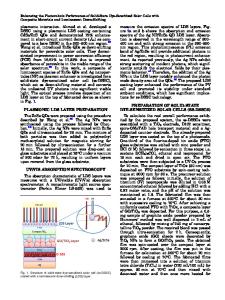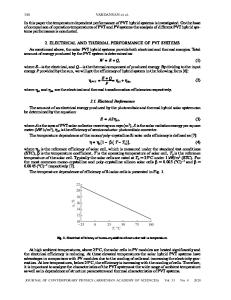Photovoltaic Properties of Polyaniline-Titania Composite for Hybrid Solar Cells Applications
- PDF / 9,139,605 Bytes
- 6 Pages / 612 x 792 pts (letter) Page_size
- 32 Downloads / 362 Views
1211-R03-18
Photovoltaic properties of polyaniline-titania composite for hybrid solar cells applications Michael I. Ibrahim1,2, Maria J. Bassil1, Umit B. Demirci2, Georges El Haj Moussa1, Vincent Salles2, Mario R. El Tahchi1 and Philippe Miele2 1
LPA-GBMI, Department of Physics, Lebanese University -Faculty of Sciences II, PO Box 90656 Jdeidet, Lebanon, email: [email protected], Tel: +961 3 209688, Fax: +961 1 681553. 2 Université Lyon 1, CNRS, UMR 5615, Laboratoire des Multimatériaux et Interfaces, 43 boulevard du 11 Novembre 1918, F-69622 Villeurbanne, France, email: [email protected].
ABSTRACT Solar energy harvesting has been extensively studied in the last three decades to provide a green energy source. Hybrid photovoltaics (HPV) based on titania (TiO2) are researched for their easiness of production and low cost. In the present study, precursor solutions are prepared by polymerizing aniline-HCl in TiO2 aqueous solutions with different concentrations in order to study the effect of polymerization kinetics on the PANI-TiO2 composite electrical properties. Industrial grade TiO2 powder with average particle size of 200 nm is used. PANI-TiO2 precursor solutions are dyed on PET substrates with metal oxide conductive coatings. Bulk PANI-TiO2 pellets are prepared for the analysis of the electrical conductivity by the four-point probe technique. The electrical properties of the obtained films and pellets are investigated to choose the optimum blend composition for HPV cell. INTRODUCTION In 1991, Grätzel invented the first dye-sensitized solar cell based on layers of TiO2, an electrolyte and Ruthenium dye [1] showing high efficiency of light energy conversion. Since then many advances have been recorded concerning the conversion efficiency and fabrication techniques [2, 3]. Conductive polymer such as polyaniline (PANI) is used in such solar cells for its chemical and environmental stability, having a controllable conductivity, high absorption in the visible range and high mobility of charge carriers. TiO2 is an n-type semiconductor of Eg=3.2 eV used in various applications for its high chemical stability, high photocatalytic activity, low cost and non-toxicity. Organic/inorganic p-n heterojunctions based on PANI and TiO2 blends have been intensively studied due to their low cost and easiness of fabrication. Liu et al. have reported a photovoltaic effect by using PANI as a hole conductor material and forming with TiO2 a p-n heterojunction [4, 5]. Other techniques have been investigated, like using the evaporationinduced self-assembly technique, mesoporous titania films with nano arrays are fabricated then filled with a conductive polymer such as poly(3-hexyl thiophene) resulting a flexible hybrid solar cell [6]. Photoelectrochromic cells can be based on such organic/inorganic layers with the addition of ruthenium dye [7]. Tan et al. have also used layers of TiO2 and PANI for solar cell fabrication and deduced that as the light intensity increases the efficiency of the cell decreases due to the fact that the elect
Data Loading...










